APPLE IPAD PRO 12.9 User Manual [nl]

Downloaded from
www . vandenborre . be
iPad User Guide
For iOS 8.4 Software
Contents
8 Chapter 1: iPad at a glance
8iPad overview
9Accessories
10Multi-Touch screen
10Sleep/Wake button
11Home button
11Volume buttons and the Side Switch
12SIM card tray
13Status icons
14Chapter 2: Get started
14 Set up iPad
14Sign up for cellular service
15Connect to Wi-Fi
15Connect to the Internet
15Apple ID
16iCloud
17Set up other mail, contacts, and calendar accounts
17Manage content on your iOS devices
18Connect iPad to your computer
19Sync with iTunes
19Date and time
20International settings
20Your iPad name
20View this user guide on iPad
20Tips for using iOS 8
21Chapter 3: Basics
21 Use apps
24 Continuity
26 Customize iPad
28 Type text
32Dictate
32Search
33Control Center
34Alerts and Notification Center
35Sounds and silence
35 Do Not Disturb
35 Sharing
38iCloud Drive
38Transfer files
39Personal Hotspot
Downloaded from
www . vandenborre . be
2
39AirPlay
40AirPrint
40Apple Pay
41Bluetooth devices
41Restrictions
41Privacy
42Security
45Charge and monitor the battery
46Travel with iPad
47Chapter 4: Siri
47Use Siri
48Siri and apps
48Tell Siri about yourself
48Make corrections
48Siri settings
49Chapter 5: Messages
49iMessage service
50Send and receive messages
51Manage conversations
51Share photos, videos, your location, and more
52Messages settings
53Chapter 6: Mail
53Write messages
54Get a sneak peek
54Finish a message later
55See important messages
56Attachments
56Work with multiple messages
57See and save addresses
57Print messages
57Mail settings
58Chapter 7: Safari
58Safari at a glance
58Search the web
59Browse the web
60Keep bookmarks
61Save a reading list for later
61Shared links and subscriptions
62Fill in forms
63Avoid clutter with Reader
63Privacy and security
64Safari settings
65Chapter 8: Music
65Music at a glance
65Access music
66Apple Music
Downloaded from
www . vandenborre . be
Contents |
3 |

66Get personalized recommendations
66For You
67Search for and add music
67Play music
68New
69Radio
70Connect
71Playlists
71iTunes Match
72My Music
72Siri
73Music settings
74Chapter 9: FaceTime
74FaceTime at a glance
75Make and answer calls
75Manage calls
76Settings
77Chapter 10: Calendar
77Calendar at a glance
78Invitations
78Use multiple calendars
79Share iCloud calendars
79Calendar settings
80Chapter 11: Photos
80View photos and videos
81Organize photos and videos
82iCloud Photo Library
82My Photo Stream
83iCloud Photo Sharing
84Other ways to share photos and videos
85Edit photos and trim videos
86Print photos
86Import photos and videos
87Photos settings
88Chapter 12: Camera
88Camera at a glance
89Take photos and videos
90HDR
91View, share, and print
91Camera settings
92Chapter 13: Contacts
92Contacts at a glance
93Add contacts
93Unify contacts
94Contacts settings
Contents
Downloaded from
www . vandenborre . be
4
www.ipadpromanuals.com
95 Chapter 14: Clock
95Clock at a glance
96Alarms and timers
97Chapter 15: Maps
97Find places
98Get more info
98Get directions
993D and Flyover
99Maps settings
100Chapter 16: Videos
100Videos at a glance
101Add videos to your library
101Control playback
102Videos settings
103Chapter 17: Notes
103Notes at a glance
104Use notes in multiple accounts
105Chapter 18: Reminders
105Reminders at a glance
106Scheduled reminders
106Location reminders
107Reminders settings
108Chapter 19: Photo Booth
108Take photos
109Manage photos
110Chapter 20: Game Center
110Game Center at a glance
111Play games with friends
111Game Center settings
112Chapter 21: Newsstand
113Chapter 22: iTunes Store
113iTunes Store at a glance
114Browse or search
115Purchase, rent, or redeem
116iTunes Store settings
117Chapter 23: App Store
117App Store at a glance
117Find apps
118Purchase, redeem, and download
119App Store settings
120Chapter 24: iBooks
120 Get books
Downloaded from
www . vandenborre . be
Contents |
5 |
120Read a book
121Interact with multimedia
122Study notes and glossary terms
122Listen to an audiobook
123Organize books
123Read PDFs
124iBooks settings
125Chapter 25: Podcasts
125Podcasts at a glance
126Get podcasts and episodes
127Control playback
128Organize your favorites into stations
128Podcasts settings
129Appendix A: Accessibility
129Accessibility features
130Accessibility Shortcut
130VoiceOver
141Zoom
142Invert Colors and Grayscale
142Speak Selection
142Speak Screen
143Speak Auto-Text
143Large, bold, and high-contrast text
143Button Shapes
143Reduce screen motion
143On/offswitch labels
143Assignable tones
144Video Descriptions
144Hearing aids
145Mono audio and balance
145Subtitles and closed captions
145Siri
145Widescreen keyboards
145Guided Access
146Switch Control
150AssistiveTouch
151Accessibility in OS X
152 Appendix B: iPad in Business
152 iPad in the enterprise
152 Mail, Contacts, and Calendar
152 Network access
152 Apps
154 Appendix C: International Keyboards
154Use international keyboards
155Special input methods
Downloaded from
www . vandenborre . be
Contents |
6 |
157 Appendix D: Safety, handling, and support
157 Important safety information
159Important handling information
160iPad Support site
160Restart or reset iPad
161Reset iPad settings
161 An app doesn’t fill the screen
161Onscreen keyboard doesn’t appear
161Get information about your iPad
162Usage information
162Disabled iPad
162VPN settings
163Profiles settings
163Back up iPad
164Update and restore iPad software
164Cellular settings
165Sell or give away iPad
165Learn more, service, and support
166FCC compliance statement
166Canadian regulatory statement
167Disposal and recycling information
168ENERGY STAR® compliance statement
168Apple and the environment
Downloaded from
www . vandenborre . be
www.ipadpromanuals.com
Contents |
7 |

iPad at a glance
iPad overview
This guide describes iOS 8.4 for:
•• iPad mini (all models)
•• iPad Air (all models)
•• iPad (3rd generation and 4th generation)
•• iPad 2 iPad mini 3
Status bar |
|
|
|
|
|
|
|
|
|
|
|
|
|
FaceTime |
||||
|
|
|
|
|
|
|
|
|
|
|
|
|
||||||
|
|
|
|
|
|
|
|
|
|
|
|
|
HD camera |
|||||
|
|
|
|
|
|
|
|
|
|
|
|
|
||||||
|
|
|
|
|
|
|
|
|
|
|
|
|
|
|
|
|
|
|
App icons |
|
|
|
|
|
|
|
|
|
|
|
|
|
|
Multi-Touch |
|||
|
|
|
|
|
|
|
|
|
|
|
|
|
||||||
|
|
|
|
|
|
|
|
|
|
|
|
|
|
|
|
|
|
|
|
|
|
|
|
|
|
|
|
|
|
|
|
|
|
|
|
||
Home |
|
|
|
|
|
|
|
|
|
|
display |
|||||||
|
|
|
|
|
|
|
|
|
|
|||||||||
button/ |
|
|
|
|
|
|
|
|
|
|
|
|||||||
Touch ID |
|
|
|
|
|
|
|
|
|
|
|
|||||||
sensor |
|
|
|
|
|
|
|
|
|
|
|
|
|
|
|
|
|
|
|
|
|
|
|
|
|
|
|
Sleep/Wake button |
|||||||||
iSight |
|
|
||||||||||||||||
|
|
|||||||||||||||||
|
|
|
|
|
|
|
|
|
|
|
||||||||
|
|
|
|
|
|
|
|
|
|
|
||||||||
camera |
|
|
|
|
|
|
|
|
|
|
|
|
|
|
|
|
Headset jack |
|
|
|
|
|
|
|
|
|
|
|
|
|
|
|
|
|
|||
Side Switch |
|
|
|
|
|
|
|
|
|
|
|
|
|
|||||
|
|
|
|
|
|
|
|
|
|
|
|
|||||||
Volume |
|
|
|
|
|
|
|
|
|
|
|
|
|
Microphones |
||||
|
|
|
|
|
|
|
|
|
|
|
|
|
|
|
||||
buttons |
|
|
|
|
|
|
|
|
|
|
|
|||||||
Speakers
Nano-SIM |
|
tray (cellular |
Lightning connector |
models) |
Downloaded from1
www . vandenborre . be
8

iPad Air 2
Status bar |
|
|
|
FaceTime |
|
|
|
||
|
|
|
HD camera |
|
|
|
|||
|
|
|
|
App icons
Multi-Touch Home display button/
Touch ID sensor
Downloaded from
www . vandenborre . be
Microphones Sleep/Wake button |
Headset jack |
iSight camera
Volume buttons
Nano-SIM tray (cellular
models)
Speakers
 Lightning connector
Lightning connector
Your features and apps may vary depending on the model of iPad you have, and on your location, language, and carrier.To find out which features are supported in your area, see www.apple.com/ios/feature-availability/.
Note: Apps and services that send or receive data over a cellular network may incur additional fees. Contact your carrier for information about your iPad service plan and fees.
Accessories
The following accessories are included with iPad:
USB power adapter. Use with the Lightning to USB Cable or the 30-pin to USB Cable to charge the iPad battery. The size of your adapter depends on the iPad model and your region.
Chapter 1 iPad at a glance |
9 |
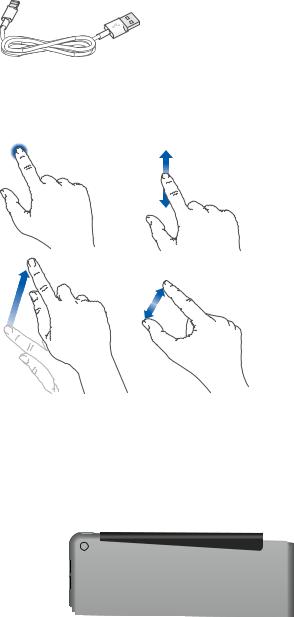

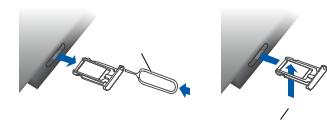
Lock the ringer and alert volumes. Go to Settings > Sounds, then turn offChange with Buttons. |
|
||
Downloaded |
|
||
To limit the volume for music and videos, go to Settings > Music > Volume Limit. |
from |
|
|
|
|
||
Note: In some European Union (EU) countries, iPad may warn that you’re setting the volu e |
|
||
above the EU recommended level for hearing safety. To increase the volume beyond this level, |
|
||
|
www |
||
you may need to briefly release the volume control.To limit the maximum headset volume |
. |
||
vandenborre |
|||
to this level, go to Settings > Music > Volume Limit, then turn on EU Volume Limit. To prevent |
|||
changes to the volume limit, go to Settings > General > Restrictions. |
|
||
Use Control Center to adjust the volume. When iPad is locked or when you’re using another |
|||
|
|
||
app, swipe up from the bottom edge of the screen to open Control Center. |
|
. |
|
|
be |
||
|
|
||
 SIM
SIM  tray Nano-SIM
tray Nano-SIM
card
Open the SIM tray. Insert a SIM eject tool (sold separately) into the hole on the SIM tray, then press firmly and push the tool straight in until the tray pops out. Pull out the SIM tray to install or replace the SIM card. If you don’t have a SIM eject tool, try the end of a small paper clip.
Important: A SIM card is required to use cellular services when connecting to GSM networks and some CDMA networks.Your iPad is subject to your wireless service provider’s policies, which may include restrictions on switching service providers and roaming, even after conclusion of any required minimum service contract. Contact your wireless service provider for more details. Availability of cellular capabilities depends on the wireless network.
For more information, see Cellular settings on page 164.
www.ipadpromanuals.com
Chapter 1 iPad at a glance |
12 |
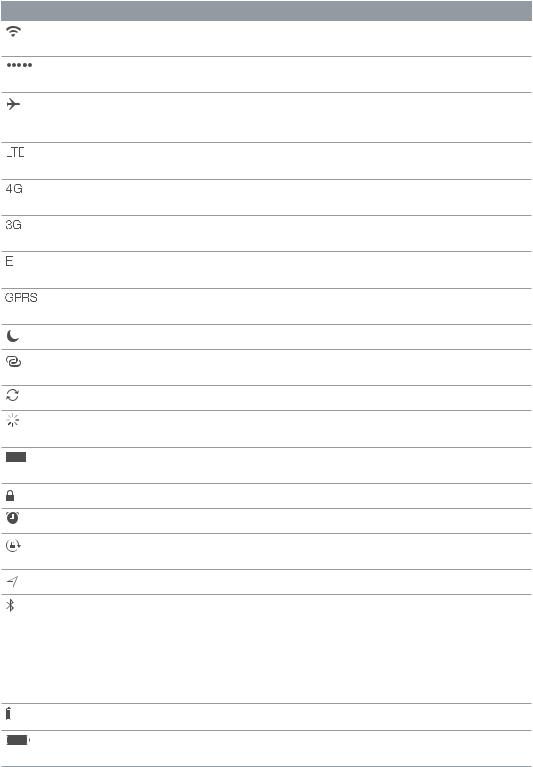
No icon: Bluetooth is not paired with a device.
See Bluetooth devices on page 41.
Shows the battery level of a supported paired Bluetooth device.
Shows the battery level or charging status. See Charge and monitor the battery on page 45.
13

|
Downloaded |
|
2 |
Get started |
from |
www |
|
|
. |
Set up iPad |
vandenborre |
. |
|
|
be |
·WARNING: To avoid injury, read Important safety information on page 157 before using iPad.
With only a Wi-Fi connection, you can easily set up iPad. You can also set up iPad by connecting it to a computer and using iTunes (see Connect iPad to your computer on page 18).
Set up iPad. Turn on iPad, then follow the Setup Assistant.
The Setup Assistant guides you through the setup process, including:
•• Connecting to a Wi-Fi network
••
••
••
••
••
Signing in with or creating a free Apple ID (needed for many features, including iCloud, FaceTime, the iTunes Store, the App Store, and more)
Entering a passcode
Setting up iCloud and iCloud Keychain
Turning on recommended features, such as Location Services Activating iPad with your carrier (cellular models)
You can also restore iPad from an iCloud or iTunes backup during setup. See Back up iPad on page 163.
Note: Find My iPad is turned on when you sign in to iCloud. Activation Lock is engaged to help prevent anyone else from setting up your iPad, even if it is completely restored. Before you sell or give away your iPad, you should reset it to erase your personal content and turn offActivation
Lock. See Sell or give away iPad on page 165.
Sign up for cellular service
If your iPad has an Apple SIM card (available on iPad models with cellular and Touch ID), you can choose a carrier and sign up for cellular service right on iPad. Depending on your home carrier and your destination, you may also be able to travel abroad with iPad and sign up for cellular service with a carrier in the country you’re visiting. This isn’t available in all areas and not all carriers are supported; contact your carrier for more information.
Sign up for cellular service. Go to Settings > Cellular Data, then tap Set Up Cellular Data and follow the onscreen instructions.
Set up cellular service in another country. When traveling to another country, you can choose a local carrier rather than roaming. Go to Settings > Cellular Data, tap Choose a Data Plan, then select the plan you want to use.
Apple SIM card kits are available for purchase at Apple Retail locations in countries with participating carriers.
14
w w w . i p a d p r o m a n u a l s . c o m

Connect to Wi-Fi |
Downloaded |
|
|
|
If |
appears at the top of the screen, you’re connected to a Wi-Fi network. iPad reconnects |
|
||
anytime you return to the same location. |
from |
|
||
ConfigureWi-Fi.Go to Settings > Wi-Fi, then turn Wi-Fi on or off. (You can also turn Wi-Fi |
www |
|||
|
on |
|||
or offin Control Center.) |
|
|
. |
|
•• |
Choose a network: Tap one of the listed networks, then enter the password, if asked. |
|
vandenborre |
|
|
|
|||
•• |
Ask to join networks: Turn on Ask to Join Networks to be prompted when a Wi-Fi network |
|
||
is available. Otherwise, you must manually join a network when a previously used network |
be |
isn’t available. |
|
|
. |
•• Forget a network: Tap  next to a network you’ve joined before, then tap Forget this Network.
next to a network you’ve joined before, then tap Forget this Network.
Set up your own Wi-Fi network. If you have a new or unconfigured AirPort base station turned on and within range, you can use iPad to set it up. Go to Settings > Wi-Fi, then look for Set up an
AirPort base station. Tap your base station and Setup Assistant does the rest.
Manage your AirPort network. If iPad is connected to an AirPort base station, go to Settings > Wi-Fi, tap  next to the network name, then tap Manage this Network. If you haven’t yet downloaded AirPort Utility, tap OK to open the App Store, then download it (this requires an Internet connection).
next to the network name, then tap Manage this Network. If you haven’t yet downloaded AirPort Utility, tap OK to open the App Store, then download it (this requires an Internet connection).
Connect to the Internet
iPad connects to the Internet whenever necessary, using a Wi-Fi connection (if available) or your carrier’s cellular network. For information about connecting to a Wi-Fi network, see Connect to Wi-Fi, above.
When an app needs to use the Internet, iPad does the following, in order:
••
••
••
Connects over the most recently used available Wi-Fi network
Shows a list of Wi-Fi networks in range, and connects using the one you choose Connects over the cellular data network, if available
Note: If a Wi-Fi connection to the Internet isn’t available, apps and services may transfer data over your carrier’s cellular network, which may result in additional fees. Contact your carrier for information about your cellular data plan rates. To manage cellular data usage, see Cellular settings on page 164.
Apple ID
Your Apple ID is the account you use for just about everything you do with Apple, including storing your content in iCloud, downloading apps from the App Store, and buying music, movies, and TV shows from the iTunes Store.
If you already have an Apple ID, use it when you first set up iPad, and whenever you need to sign in to use an Apple service. If you don’t already have an Apple ID, you can create one whenever you’re asked to sign in. You only need one Apple ID for everything you do with Apple.
For more information, see appleid.apple.com.
Chapter 2 Get started |
15 |
iCloud |
Downloaded |
|
iCloud offers free mail, contacts, calendar, and other features that you can set up simply by |
|
|
signing in to iCloud with your Apple ID, then making sure that the features you want fromto use are |
|
|
turned on. |
www |
|
|
||
Set up iCloud. Go to Settings > iCloud. Create an Apple ID if needed, or use your existing one. . |
||
iCloud stores your photos and videos, documents, music, calendars, contacts, and more. Content |
vandenborre |
|
stored in iCloud is pushed wirelessly to your other iOS devices and computers signed in to |
||
iCloud with the same Apple ID. |
|
|
|
|
. |
|
|
be |
iCloud is available on devices with iOS 5 or later, on Mac computers with OS X Lion v10.7.5 or later, and on PCs with iCloud for Windows 4.0 (Windows 7 or Windows 8 is required). You can also sign in to iCloud.com from any Mac or PC to access your iCloud information and features like Photos, Find My iPhone, Mail, Calendar, Contacts, iWork for iCloud, and more.
•• Music,Movies,TV Shows,Apps,and Books: Automatically get iTunes purchases on all your devices set up with iCloud, or download previous iTunes music and TV show purchases for free, anytime. With an iTunes Match subscription, all your music, including music you’ve imported from CDs or purchased somewhere other than the iTunes Store, can also be stored in iCloud and played on demand. See iTunes Match on page 71. Download previous App Store and iBooks Store purchases to iPad for free, anytime.
•• Photos: Use iCloud Photo Library to store all your photos and videos in iCloud, and access them from any iOS 8.1 or later device, Mac with OS X Yosemite v10.10.3 or later, and on iCloud.com using the same Apple ID. Use iCloud Photo Sharing to share photos and videos with just the people you choose, and let them add photos, videos, and comments. See iCloud Photo Library on page 82. See iCloud Photo Sharing on page 83.
•• Family Sharing: Up to six family members can share their purchases from the iTunes Store, App Store, and iBooks Store. Pay for family purchases with the same credit card and approve kids’ spending right from a parent’s device. Plus, share photos, a family calendar, and more. See Family Sharing on page 36.
•• iCloud Drive: Safely store your presentations, spreadsheets, PDFs, images, and other documents in iCloud, and access them from your iPad, iPhone, iPod touch, Mac, or PC. iCloud Drive is available on any iOS 8 or later device and on any Mac with OS X Yosemite v10.10.0 or later. If you’re using an earlier version of iOS, see Set up iCloud Drive on page 38.
•• Mail,Contacts,Calendars: Keep your mail, contacts, calendars, notes, and reminders up to date across all your devices.
•• SafariTabs: See the tabs you have open on your other iOS devices and OS X computers. See Browse the web on page 59.
•• Backup: Back up iPad to iCloud automatically when connected to power and Wi-Fi. iCloud data and backups sent over the Internet are encrypted. See Back up iPad on page 163.
•• Find My iPad: Locate your iPad on a map, display a message, play a sound, lock the screen, temporarily suspend or permanently remove your credit and debit cards in Passbook & Apple Pay settings used for Apple Pay, or remotely wipe your iPad data. Find My iPad includes
Activation Lock, which requires your Apple ID and password in order to turn offFind My iPad or erase your device. Your Apple ID and password are also required before anyone can reactivate your iPad. See Find My iPad on page 44.
Chapter 2 Get started |
16 |
•• |
Find My Friends: Share your location with people who are important to you. Download the free |
|
||
|
app from the App Store. |
Downloaded |
|
|
•• |
iCloud Keychain: Keep your passwords and credit card information up to date acrossfromall your |
|
||
|
designated devices. See iCloud Keychain on page 43. |
www |
||
|
|
|||
You must have an iCloud account and be signed in to iCloud to use Apple Pay. See Apple Pay on |
. |
|||
vandenborre |
||||
page 40. |
|
|||
With iCloud, you get a free email account and 5 GB of storage for your mail, documents, photos, |
||||
and backups. Your purchased music, apps, TV shows, and books, as well as your photo streams, |
||||
don’t count against your available space. |
|
. |
||
|
be |
|||
•• iTunes Store: You can access your purchased songs and videos in the Music and Videos apps. Or, in the iTunes Store, tap Purchased  .
.
•• App Store: Go to the App Store, then tap Purchased  .
.
•• iBooks Store: Go to iBooks, then tap Purchased  .
.
Turn on Automatic Downloads for music, apps, or books. Go to Settings > iTunes & App Store.
For more information about iCloud, see www.apple.com/icloud/. For support information, see www.apple.com/support/icloud/.
Set up other mail, contacts, and calendar accounts
iPad works with Microsoft Exchange, and many of the most popular Internet-based mail, contacts, and calendar services.
Set up another account. Go to Settings > Mail, Contacts, Calendars > Add Account.
You can add contacts using an LDAP or CardDAV account, if your company or organization supports it. See Add contacts on page 93.
You can add calendars using a CalDAV calendar account, and you can subscribe to iCalendar (.ics) calendars or import them from Mail. See Use multiple calendars on page 78.
For information about setting up a Microsoft Exchange account in a corporate environment, see Mail, Contacts, and Calendar on page 152.
Manage content on your iOS devices
You can transfer information and files between iPad and your other iOS devices and computers, using either iCloud or iTunes.
••
••
iCloud stores your photos and videos, documents, music, calendars, contacts, and more. It all gets pushed wirelessly to your other iOS devices and computers, keeping everything up to date. See iCloud on page 16.
iTunes syncs music, videos, photos, and more between your computer and iPad. Changes you make on one device are copied to the other when you sync. You can also use iTunes to copy a file to iPad for use with an app, or to copy a document you’ve created on iPad to your computer. See Sync with iTunes on page 19.
Chapter 2 Get started |
17 |
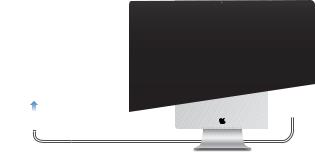
You can use iCloud or iTunes, or both, depending on your needs. For example, you can use |
|
|
|
Downloaded |
|
iCloud Photo Stream to automatically keep your contacts and calendars up to date on all your |
|
|
devices, and use iTunes to sync music from your computer to iPad. |
from |
|
Important: To avoid duplicates, keep contacts, calendars, and notes in sync using iCloud or |
|
|
iTunes, but not both. |
www |
|
|
. |
|
|
vandenborre |
|
You can also choose to manually manage content from iTunes by selecting that option in the |
||
iPad Summary pane. Then you can drag songs or videos from your iTunes library to iPad in |
||
iTunes.This is useful if your iTunes library contains more items than can fit on your iPad. |
||
|
|
. |
Note: If you use iTunes Match, you can manually manage only video. |
|
be |
|
|
|
Connect iPad to your computer
Connecting iPad to your computer lets you sync content using iTunes. You can also sync with iTunes wirelessly. See Sync with iTunes on page 19.
To use iPad with your computer, you need:
•• An Internet connection for your computer (broadband is recommended)
•• A Mac with a USB 2.0 or 3.0 port, or a PC with a USB 2.0 port, and one of the following operating systems:
•• OS X version 10.6.8 or later
•• Windows 8, Windows 7, Windows Vista, or Windows XP Home or Professional with Service Pack 3 or later
•• iTunes, available at www.itunes.com/download/
Connect iPad to your computer. Use the included Lightning to USB Cable or 30-pin to USB Cable.
Unless iPad is actively syncing with your computer, you can disconnect it at any time. Look at the top of the iTunes screen on your computer or on iPad to see if syncing is in progress. If you disconnect iPad while it’s syncing, some data may not get synced until the next time you connect iPad to your computer.
Chapter 2 Get started |
18 |
••
••
••
••
••
••
••
••
If iPad doesn’t appear in iTunes, make sure you’re using the latest version of iTunes, check that the included cable is correctly connected, then try restarting your computer.
In the Summary pane, you can set iTunes to sync iPad automatically when it’s attached to your computer. To temporarily prevent syncing when you attach the device, hold down Command and Option (Mac) or Shift and Control (PC) until you see iPad appear in the iTunes window.
If you want to encrypt the information stored on your computer when iTunes makes a backup, select “Encrypt iPad backup” in the Summary pane. Encrypted backups are indicated by a lock icon  , and a password is required to restore the backup. If you don’t select this option, other passwords (such as those for mail accounts) aren’t included in the backup and you’ll have to reenter them if you use the backup to restore iPad.
, and a password is required to restore the backup. If you don’t select this option, other passwords (such as those for mail accounts) aren’t included in the backup and you’ll have to reenter them if you use the backup to restore iPad.
In the Info pane, click Advanced to select options that let you replace the information on iPad with the information from your computer during the next sync.
In the Music pane, you can sync music using your playlists.
In the Photos pane, you can sync photos and videos from a supported app or folder on your computer.
If you use iCloud to store your contacts, calendars, and bookmarks, don’t also sync them to iPad using iTunes.
If you turn on iCloud Photo Library, you can’t use iTunes to sync photos and videos to iPad.
Date and time
The date and time are usually set for you based on your location—take a look at the Lock screen to see if they’re correct.
Set whether iPad updates the date and time automatically. Go to Settings > General > Date &
Time, then turn Set Automatically on or off. If you set iPad to update the time automatically, it gets the correct time over the network and updates it for the time zone you’re in. Some networks don’t support network time, so in some areas iPad may not be able to automatically determine the local time.
Set the date and time manually. Go to Settings > General > Date & Time, then turn offSet
Automatically.
Set whether iPad shows 24-hour time or 12-hour time. Go to Settings > General > Date & Time, then turn 24-Hour Time on or off. (24-Hour Time may not be available in all areas.)
Chapter 2 Get started |
19 |
International settings |
Downloaded |
||
Go to Settings > General > Language & Region to set: |
from |
||
•• |
The language for iPad |
||
www |
|||
•• |
The preferred language order for apps and websites |
||
. |
|||
•• |
The region format |
||
vandenborre |
|||
•• |
The calendar format |
||
|
|||
•• |
Advanced settings for dates, times, and numbers |
|
|
To add a keyboard for another language, go to Settings > General > Keyboard > Keyboards. |
. |
For more information, see Use international keyboards on page 154. |
be |
|
Your iPad name
The name of your iPad is used by iTunes and iCloud.
Change the name of your iPad. Go to Settings > General > About > Name.
View this user guide on iPad
You can view the iPad User Guide on iPad in Safari, and in the iBooks app.
View the user guide in Safari. In Safari, tap  , then tap the iPad User Guide bookmark. Or go to help.apple.com/ipad/.
, then tap the iPad User Guide bookmark. Or go to help.apple.com/ipad/.
•• Add an icon for the guide to the Home screen: Tap  , then tap Add to Home Screen.
, then tap Add to Home Screen.
•• View the guide in a different language: Tap Change Language at the bottom of the home page. View the user guide in iBooks. Open iBooks, then search for “iPad user” in the iBooks Store.
For more information about iBooks, see Chapter 24, iBooks, on page 120.
Tips for using iOS 8
The Tips app helps you get the most from iPad.
Get Tips. Open the Tips app. New tips are added weekly.
Get notified when new tips arrive.Go to Settings > Notifications > Tips.
Chapter 2 Get started |
20 |

|
Downloaded |
|
3 |
Basics |
from |
www |
|
|
. |
Use apps |
vandenborre |
. |
|
|
be |
All the apps that come with iPad—as well as the apps you download from the App Store—are on the Home screen.
Start at home
Tap an app to open it.
Press the Home button anytime to return to the Home screen. Swipe left or right to see other screens.
www.ipadpromanuals.com
21

Multitasking |
Downloaded |
|
|
||
iPad helps you manage several tasks at the same time. |
from |
|
|||
|
|
|
|||
View contacts and open apps. Double-click the Home button to reveal the multitasking |
www |
||||
screen. Swipe left or right to see more. To switch to another app, tap it. To connect with a |
|||||
|
|
||||
recent or favorite contact, tap the contact’s picture or name, then tap your preferred method |
. |
||||
of communication. |
|
|
vandenborre |
||
|
|
|
|||
|
|
|
|
. |
|
|
|
|
|
||
|
|
|
|
be |
|
|
|
|
|
|
|
Close an app. If an app isn’t working properly, you can force it to quit. Drag the app up from the multitasking screen. Then try opening the app again.
If you have lots of apps, you can use Spotlight to find and open them. Drag down the center of the Home screen to see the search field. See Spotlight Search on page 32.
Look around
Drag a list up or down to see more. Swipe to scroll quickly; touch the screen to stop it. Some lists have an index—tap a letter to jump ahead.
Drag a photo, map, or webpage in any direction to see more.
To quickly jump to the top of a page, tap the status bar at the top of the screen.
Chapter 3 Basics |
22 |
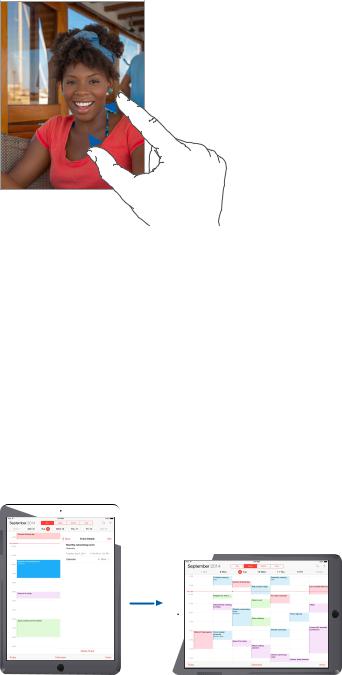
Zoom in or out |
Downloaded |
Pinch open on a photo, webpage, or map for a close-up—then pinch closed to zoom back out. In |
|
Photos, keep pinching to see the collection or album the photo’s in. |
from |
|
www |
|
. |
|
vandenborre |
|
. |
|
be |
Or double-tap a photo or webpage to zoom in, then double-tap again to zoom out. In Maps, double-tap to zoom in, then tap once with two fingers to zoom out.
Multitasking gestures
You can use multitasking gestures on iPad to return to the Home screen, reveal the multitasking display, or switch to another app.
Return to the Home screen. Pinch four or five fingers together.
Reveal the multitasking display. Swipe up with four or five fingers.
Switch apps. Swipe left or right with four or five fingers.
Turn multitasking gestures on or off.Go to Settings > General > Multitasking Gestures.
Change the screen orientation
Many apps give you a different view when you rotate iPad.
Lock the screen orientation. Swipe up from the bottom edge of the screen to open Control Center, then tap  .
.
The orientation lock icon  appears in the status bar when the screen orientation is locked.
appears in the status bar when the screen orientation is locked.
You can also set the Side Switch to lock the screen orientation instead of silencing sound effects and notifications. Go to Settings > General then, under“Use Side Switch to,”tap Lock Rotation.
Chapter 3 Basics |
23 |
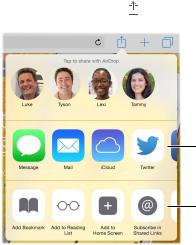
App extensions |
Downloaded |
Some apps let you extend the functionality of your apps on iPad. An app extension may appear |
|
as a sharing option, action option, a widget in Notification Center, a file provider, or afromcustom |
|
keyboard. For example, if you download Pinterest to iPad, Pinterest becomes another option for |
|
sharing when you click . |
www |
|
. |
|
vandenborre |
|
. |
|
be |
Sharing options
Action options
App extensions can also help you edit a photo or video in your Photos app. For example, you can download a photo-related app that lets you apply filters to photos from your Photos app.
Install app extensions. Download the app from the App Store, open the app, then follow the onscreen instructions.
Turn sharing or action options on or off.Tap  , then tap More (drag options to the left if necessary).Turn offthird-party sharing or action options (they are on by default).
, then tap More (drag options to the left if necessary).Turn offthird-party sharing or action options (they are on by default).
Organize sharing and action options. Tap  , then tap More (drag options to the left if necessary). Touch and drag
, then tap More (drag options to the left if necessary). Touch and drag  to rearrange your options.
to rearrange your options.
For more information about Notification Center widgets, see Notification Center on page 34. For more information about Sharing options, see Share from apps on page 35.
Continuity
About Continuity features
Continuity features connect iPad with your iPhone, iPod touch, and Mac so they can work together as one. You can start an email or document on iPad, for example, then pick up where you left offon your iPod touch or Mac. Or let iPad use iPhone to make phone calls or send SMS or MMS text messages.
Continuity features require iOS 8 or OS X Yosemite, and work with iPhone 5 or later, iPod touch (5th generation) or later, iPad (4th generation) or later, and supported Mac computers. For more information, see support.apple.com/kb/HT6337.
Handoff
Pick up on one device where you left offon another.You can use Handoffwith Mail, Safari, Pages,
Numbers, Keynote, Maps, Messages, Reminders, Calendar, Contacts, and even some third-party apps. For Handoffto work, your devices must be signed in to iCloud using the same Apple ID, and they must be within Bluetooth range of one another (about 33 feet or 10 meters).
Chapter 3 Basics |
24 |
25
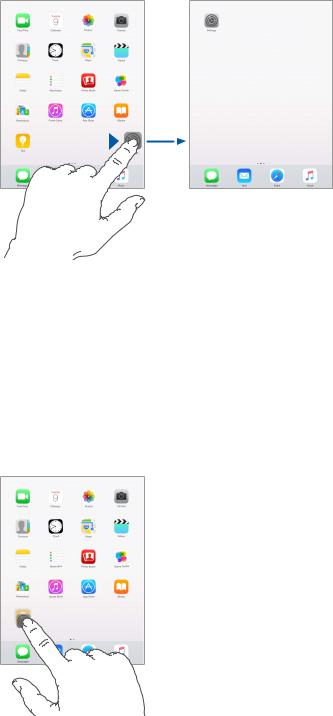
Customize iPad |
Downloaded |
|
|
Arrange your apps |
from |
|
|
Arrange apps. Touch and hold any app on the Home screen until it jiggles, then drag apps |
|
||
around. Drag an app to the edge of the screen to move it to a different Home screen, or towwwthe |
|||
Dock at the bottom of the screen. Press the Home button to save your arrangement. |
. |
||
vandenborre |
|||
|
|
||
|
|
. |
|
|
|
be |
|
Create a new Home screen. While arranging apps, drag an app to the right edge of the last Home screen. The dots above the Dock show which of your Home screens you’re viewing.
When iPad is connected to your computer, you can customize the Home screen using iTunes. In iTunes, select iPad, then click Apps.
Start over. Go to Settings > General > Reset, then tap Reset Home Screen Layout to return the Home screen and apps to their original layout. Folders are removed and the original wallpaper is restored.
Organize with folders
Create a folder. While arranging apps, drag one app onto another. Tap the name of the folder to rename it. Drag apps to add or remove them. Press the Home button when you finish.
You can have multiple pages of apps in a folder.
Delete a folder. Drag out all the apps—the folder is deleted automatically.
Chapter 3 Basics |
26 |
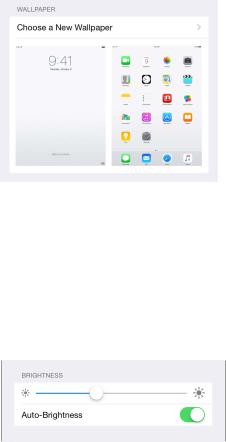
Change the wallpaper |
Downloaded |
|
|
Wallpaper settings let you set an image or photo as wallpaper for the Lock screen or Home |
|||
screen. You can choose from dynamic and still images. |
from |
||
Change the wallpaper. Go to Settings > Wallpaper > Choose a New Wallpaper. |
www |
||
|
|
|
|
|
|
|
. |
|
|
|
vandenborre |
|
|
|
. |
|
|
|
be |
|
|
|
|
When choosing an image for new wallpaper, the Perspective Zoom button determines whether your selected wallpaper is zoomed. For wallpaper you already set, go to the Wallpaper setting, then tap the image of the Lock screen or Home screen to see the Perspective Zoom button.
Note: The Perspective Zoom button doesn’t appear if Reduce Motion (in Accessibility settings) is turned on. See Reduce screen motion on page 143.
Adjust the screen brightness
Dim the screen to extend battery life, or use Auto-Brightness.
Adjust the screen brightness. Go to Settings > Display & Brightness, then drag the slider. If Auto-
Brightness is on, iPad adjusts the screen brightness for current light conditions using the built-in ambient light sensor.You can also adjust the brightness in Control Center.
Chapter 3 Basics |
27 |

Type text |
Downloaded |
|
||
The onscreen keyboard lets you enter text when needed. |
from |
|
||
Enter text |
|
|||
|
|
|||
Tap a text field to see the onscreen keyboard, then tap letters to type. If you touch the wrongwww |
||||
key, you can slide your finger to the correct key.The letter isn’t entered until you release your |
. |
|||
vandenborre |
||||
finger from the key. |
|
|||
|
|
|||
|
|
|
. |
|
|
|
|
||
|
|
|
be |
|
|
|
|
|
|
Tap Shift to type uppercase, or touch the Shift key and slide to a letter. Double-tap Shift for caps lock. To enter numbers, punctuation, or symbols, tap the Number key 
 or the Symbol key
or the Symbol key

 . If you haven’t added any keyboards, tap
. If you haven’t added any keyboards, tap  to switch to the emoji keyboard. If you have several keyboards, tap
to switch to the emoji keyboard. If you have several keyboards, tap  to switch to the last one you used. Continue tapping to access other enabled keyboards, or touch and hold
to switch to the last one you used. Continue tapping to access other enabled keyboards, or touch and hold  , then slide to choose a different keyboard.To quickly end a sentence with a period and a space, just double-tap the space bar.
, then slide to choose a different keyboard.To quickly end a sentence with a period and a space, just double-tap the space bar.
Enter accented letters or other alternate characters. Touch and hold a key, then slide to choose one of the options.
Hide the onscreen keyboard. Tap the Keyboard key  .
.
If you see a word underlined in red, tap it to see suggested corrections. If the word you want doesn’t appear, type the correction.
Chapter 3 Basics |
28 |
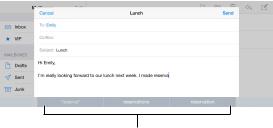
|
Downloaded |
As you write, the keyboard predicts your next word (not available in all languages). Tap a word |
|
to choose it, or accept a highlighted prediction by entering a space or punctuation. When you |
|
tap a suggested word, a space appears after the word. If you enter a comma, period, orfromother |
|
punctuation, the space is deleted. Reject a suggestion by tapping your original word (shown as |
|
the predictive text option with quotation marks). |
www |
|
. |
|
vandenborre |
|
|
|
. |
|
be |
|
|
Predictive text
Hide predictive text. Pull down the suggested words. Drag the bar up when you want to see the suggestions again.
Turn off predictive text.Touch and hold  or
or  , then slide to Predictive.
, then slide to Predictive.
If you turn offpredictive text, iPad may still try to suggest corrections for misspelled words. Accept a correction by entering a space or punctuation, or by tapping return.To reject a correction, tap the“x.”If you reject the same suggestion a few times, iPad stops suggesting it.
Set options for typing or add keyboards. Go to Settings > General > Keyboard.
You can also use an Apple Wireless Keyboard to enter text. See Use an Apple Wireless Keyboard on page 30. To dictate instead of typing, see Dictate on page 32.
Chapter 3 Basics |
29 |
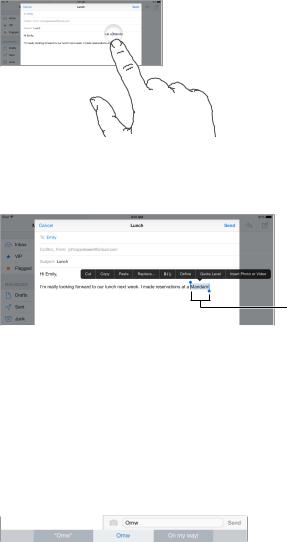
Edit text |
Downloaded |
|
Revise text. Touch and hold the text to show the magnifying glass, then drag to position the |
||
insertion point. |
from |
|
www |
||
|
||
|
. |
|
|
vandenborre |
|
|
. |
|
|
be |
|
Select text. Tap the insertion point to display the selection options. Or double-tap a word to select it. Drag the grab points to select more or less text. In read-only documents, such as webpages, touch and hold to select a word.
Grab points
You can cut, copy, or paste over selected text. With some apps, you can also get bold, italic, or underlined text (tap B/I/U);get the definition of a word;or have iPad suggest an alternative.You may need to tap  to see all the options.
to see all the options.
Undo the last edit. Shake iPad, then tap Undo.
Justify text. Select the text, then tap the left or right arrow (not always available).
Save keystrokes
A shortcut lets you enter a word or phrase by typing just a few characters. For example, type
“omw” to enter “On my way!”That one’s already set up for you, but you can also add your own.
Create a shortcut. Go to Settings > General > Keyboard, then tap Shortcuts.
Have a word or phrase you use and don’t want it corrected? Create a shortcut, but leave the
Shortcut field blank.
Use iCloud to keep your personal dictionary up to date on your other devices. Go to Settings > iCloud, then turn on iCloud Drive or Documents & Data.
Use an Apple Wireless Keyboard
You can use an Apple Wireless Keyboard (available separately) to enter text on your iPad. The keyboard connects via Bluetooth, so you must first pair it with iPad.
Note: The Apple Wireless Keyboard may not support keyboard features that are on your device. For example, it doesn’t anticipate your next word or automatically correct misspelled words.
Pair an Apple Wireless Keyboard with iPad. Turn on the keyboard, go to Settings > Bluetooth and turn on Bluetooth, then tap the keyboard when it appears in the Devices list.
Chapter 3 Basics |
30 |
